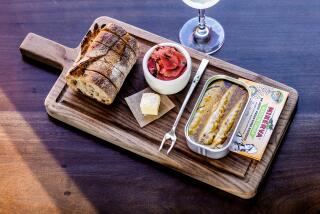The Monkfish--Ugly, Mean and Trendy
- Share via
“A brute,” writes British food author Elizabeth David. “Extremely ugly,” add the writers of “The California Seafood Cookbook.” Fish expert Alan Davidson tosses the beast into a section called “miscellaneous uncouth fish” in his book “North Atlantic Seafood.”
One might expect more elegant descriptions for a fish that regularly shows up on the plates of the most civilized restaurants in town; it seems that these days, everyone wants to eat monkfish. Camelions, La Toque, Citrus and Spago are just some of the trendier places that serve it.
But there was a time when monkfish was the Jerry Lewis of the fish world--big in France, unappreciated in the United States.
“Ten, 11 years ago I used to try to sell monkfish to the chefs in Chinatown but they’d always throw it in the trash,” says Bay Area fish dealer Peter Bird, who claims to have been the first to introduce monkfish in California. “And fishermen would practically give it away at 20 cents a pound. To them it was junkfish--garbage. Now they don’t throw any of it away; they even send me little half-inch monkfish tails.”
You can hardly blame people for being slow to catch on. A monkfish isn’t just ugly, it’s mean. As if mottled skin, an unsightly overbite and a bizarre figure aren’t enough tools for a predator fish, the monkfish comes with its own “fishing rod” that makes it, according to author, Davidson, “superbly equipped for the practice of gluttony.” It even grows its own “bait” (a piece of skin tissue) to attract other fish. Oddly, it has no scales, which means that it is not kosher.
What’s more, the monkfish is confusing; it goes by more names than a character in “War and Peace.” The name monkfish is actually British; most Americans know it as angler. In France, it’s lotte or baudroie; in Spain, rape. Because of its voracious appetite it also has a series of nicknames: bellyfish, goosefish, allmouth, bellows fish and, because it will devour almost any living thing in its path, lawyer fish.
La Toque’s Ken Frank knows the bad reputation of the monkfish but loves it anyway. “It’s my current favorite fish,” says Frank, who was one of the few chefs in California to use monkfish ten years ago. “Any other fish would crumble to garbage if you tried to roast it and then slice it. But monkfish is versatile. You can even take a sheet of it and pound it like scaloppine.”
But, he warns, “there is great monkfish and there is awful monkfish. I only use imported French angler.”
Frank gets his once-a-week shipments of lotte from one of France’s most acclaimed fishermen. It isn’t cheap but Frank says that the price is worth paying. “American monkfish has a strong, grainy texture,” he says. “It isn’t as pristine as the French, which is pearly white, sweet and delicate. But it’s a hard fish to cook perfectly.”
Patricia Unterman, co-owner of San Francisco’s Hayes Street Grill, the birthplace of the mesquite-grilled fish phenomenon, was another early monkfish devotee. “It looks weird and kind of tastes like a lobster,” Unterman says. “And for a long time, it was cheap, cheap, cheap.”
“Poor man’s lobster” is another monkfish nickname. But not for long. “There is no more poor man’s lobster,” Bird says. He now charges up to $8 a pound for the fish he once couldn’t give away. “Everyone has smartened up.”
And yet, like any fad, the true insiders have moved on to other species. Despite the fact that most people still haven’t heard of monkfish, Unterman feels that the trend has reached its peak. “The monkfish craze was part of the whole discovery of fish as an important new food,” she says. “But it’s already come and gone.”
“I don’t really care about fads and my customers couldn’t care less either,” Frank says. “I’ve learned to like lotte a lot.”
More to Read
Eat your way across L.A.
Get our weekly Tasting Notes newsletter for reviews, news and more.
You may occasionally receive promotional content from the Los Angeles Times.










